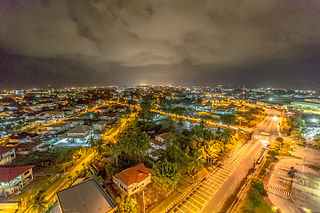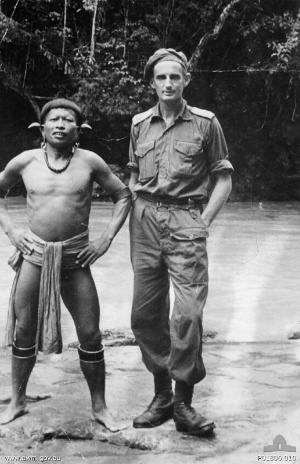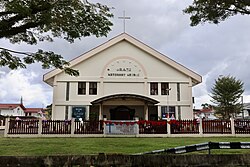
Belait District, or simply Belait, is the largest as well as the westernmost district in Brunei. It has an area of 2,727 square kilometres (1,053 sq mi) and the population of 69,062 as of 2016. The administrative town is Kuala Belait, located at the mouth of the Belait River. The district is commonly associated with the oil and gas industry of the country, mainly concentrated near the town of Seria.

Miri is a coastal city in north-eastern Sarawak, Malaysia, located near the border of Brunei, on the island of Borneo. The city covers an area of 997.43 square kilometres (385.11 sq mi), located 798 kilometres (496 mi) north-east of Kuching and 329 kilometres (204 mi) south-west of Kota Kinabalu. Miri is the second-largest city in Sarawak, with a population of 356,900 as of 2020. The city is also the capital of Miri District, Miri Division.

The Brunei revolt or the Brunei rebellion of 1962 was a December 1962 insurrection in the British protectorate of Brunei by opponents of its monarchy and its proposed inclusion in the Federation of Malaysia who wanted to establish a republic. The insurgents were members of the TNKU, a militia supplied by Indonesia and linked to the left-wing Brunei People's Party (BPP), which favoured a North Borneo Federation. The TNKU began co-ordinated attacks on the oil town of Seria, on police stations, and on government facilities around the protectorate. The revolt began to break down within hours, having failed to achieve key objectives such as the capture of Brunei Town and Sultan Omar Ali Saifuddien III. The revolt influenced the Sultan's 1963 decision not to join Malaysia. It is seen as one of the first stages of the Indonesia–Malaysia confrontation.

Kuala Belait is the administrative town of Belait District, Brunei. The population of the town proper was 4,259 in 2016. Kuala Belait is officially a municipal area, as well as a village under the mukim of the same name. The town is located 85 kilometres (53 mi) west of the country's capital Bandar Seri Begawan, and 20 kilometres (12 mi) west of Seria, the district's other town. It is also in the westernmost part of country, near the mouth of the Belait River.

Seria is a town in Belait District, Brunei, about 65 kilometres (40 mi) west from the country's capital Bandar Seri Begawan. The total population was 3,625 in 2016. It was where oil was first struck in Brunei in 1929 and has since become a centre for the country's oil and gas industry. The town's bazaar, officially opened on 19th September 1954, has few retail establishments, fresh food markets, supermarkets, banking services, tourist information centers, and a range of restaurants, including Malay, Chinese, Indian, Indonesian and Italian ones as well as outdoor dining in somewhat rustic settings. For processing documentation related to owning a car and hiring domestic helpers (amahs), government offices are located in Kuala Belait.

The Battle of Borneo was a successful campaign by Japanese Imperial forces for control of Borneo island and concentrated mainly on the subjugation of the Raj of Sarawak, Brunei, North Borneo, and the western part of Kalimantan that was part of the Dutch East Indies. The Japanese main unit for this mission was the 35th Infantry Brigade led by Major General Kiyotake Kawaguchi.

Bintulu is a coastal town on the island of Borneo in the central region of Sarawak, Malaysia. Bintulu is located 610 kilometres northeast of Kuching, 216 kilometres northeast of Sibu, and 200 kilometres southwest of Miri. With a population of 114,058 as of 2010, Bintulu is the capital of the Bintulu District of the Bintulu Division of Sarawak, Malaysia.

Marudi is a town in the Malaysian state of Sarawak, and is a part of the division of Miri. It is the seat of Marudi District, and is located on the banks of Baram River, about 100 kilometres (62 mi) upstream from the river mouth. Marudi was the administrative centre of the northern region of Sarawak before Miri was established in 1910. Marudi is considered as the cultural heart of the Orang Ulu, the highland tribes of Sarawak. It is also a transit gateway to Kelabit Highlands and Gunung Mulu National Park, a UNESCO World Heritage Site.

Kampong Sungai Teraban is a village in Belait District, Brunei, near the district's principal town Kuala Belait. It has an area of 22 square kilometres (8.5 sq mi); the population was 1,082 in 2016. It is one of the administrative villages within Mukim Kuala Belait.

Mukim Kuala Belait is a mukim in Belait District, Brunei. The population was 31,308 in 2016. The mukim encompasses Kuala Belait, the administrative town of the district.

Rasau is an area in Brunei. The area contains one of the two oil fields of Brunei, the Rasau Field, and a small village, Kampong Rasau, which has a population of 103.

Sungai Tujoh, is the westernmost point of Brunei. It is located in the Belait district.

Mukim Labi is a mukim in the interior of Belait District, Brunei. It has an area of 361.8 square kilometres (139.7 sq mi); the population was 1,216 in 2016.
The Diocese of Kuching is a diocese of the Anglican Church of the Province of South East Asia that covers Sarawak and Brunei. Founded in 1962, the see was originally established as the Bishopric of Sarawak linked to the Diocese of Labuan in 1855. The current bishop is the Most Rev'd Danald Jute, 14th Lord Bishop of the Diocese of Kuching and Brunei, who was consecrated on 13 August 2017. His seat is at St. Thomas' Cathedral, Kuching.

Major Gordon Senior 'Toby' Carter DSO was a New Zealand surveyor and road engineer who worked in Sarawak, Borneo prior to World War II for Shell Oil. He enlisted with the British Army during the war, and served in the Royal Australian Engineers and later in Z Special Unit in Borneo, where he was the Officer in Command of the Semut II operation in the Kelabit Highlands of Sarawak. In 1962 Carter had the initial idea for and was the driving force behind the establishment of both the Kinabalu National Park and the Kundasang War Memorial and Gardens near Mount Kinabalu in Sabah.

Bekenu is a small fishing town near Miri, in Sarawak, Malaysia. Bekenu bazaar is the capital of the Sibuti subdistrict, Subis district, Miri Division.
Lutong Airport(IATA: LUT, ICAO: WMLU) was an airport serving Lutong, a satellite town north of Miri, Sarawak, Malaysia. The airstrip used to belong to Royal Dutch Shell. It was opened during World War II and renovated in 1954, and it continued to operate until the inauguration of the new Miri Airport during the 1980s. The airport was decommissioned in the early 2000s and its terminal and hangars have been demolished, with only the landing strip preserved. The strip was used for racing until the deteriorating condition of the strip rendered it unsuitable for car drag racing.

Seria oil field also known as Seria Field is the largest oil field in northwest Borneo, discovered in 1929. The oil is accumulated in Upper Miocene sandstone, trapped in Seria Anticline that straddles the present day coastline. This field has produced more than 1 billion barrels of oil for more than 75 years. Brunei Shell Petroleum (BSP) is the operator of this field.

Transport in Brunei consists of air, land, and sea transport. Previously there was some rail transport in Brunei, but eventually most of it was closed down. Several public and commercial sector organizations are in charge of creating and overseeing these networks and infrastructures. The Ministry of Transport and Infocommunications (MTIC) is in charge of overseeing the maritime and aviation industries, as well as planning and regulating all kinds of land transportation.

Kampong Kuala Tutong, also simply known as Kuala Tutong, is a village in Tutong District, Brunei, within the mukim of Pekan Tutong. The postcode for Kampong Kuala Tutong is TA3341.





















